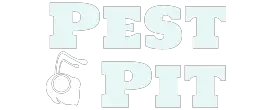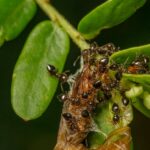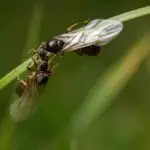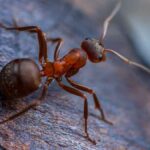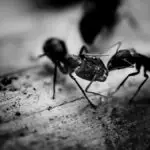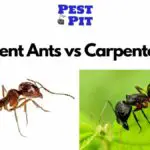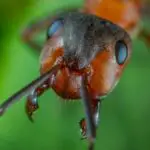Ants, while small, are a formidable force when they infiltrate our homes, creating unwanted avenues in our kitchens, bathrooms, and other places. With thousands of species worldwide, ants possess unique behaviors and biology that make them highly adaptable.
Understanding their lifestyle, their cycle of life, and how they behave is the cornerstone for their effective removal and future prevention of infestations. This knowledge also allows us to identify the specific species of ant we are dealing with, which is crucial as it helps us devise a suitable method for their control.
This guide will delve into the different characteristics and behaviors of ants, discuss practical methods of control, from natural remedies to chemical interventions, and will introduce you to professional extermination when the situation demands.
Understanding Ant Biology
Understanding ant biology is profoundly paramount when it comes to effective ant removal. And it’s not just about knowing what those minuscule creatures look like! An in-depth grasp of their lifecycle, social structure, and feeding habits can make a monumental difference in the success of your ant removal efforts. So, let’s mobilize our intellect and dive right into the heart of the matter!
Ants, like humans, are social creatures living in colonies. A single ant colony can comprise hundreds of thousands of ants, divided into three main categories – the workers, the males, and the queen. The workers are the ones you will most often see scurrying about on a hunt for food. The sole purpose of males is to mate with the queen, after which they die. As for the queen? She’s the true powerhouse of the ant colony, with her prime function being laying eggs to increase the colony’s population.
Why is this information essential? If you merely eliminate the worker ants, the queen will keep producing more. Therefore, a comprehensive removal strategy must involve targeting the queen ant.
Now, let’s talk about their lifecycle – a crucial part of ant biology. While ants have different lifespans, ranging from several weeks to years, their lifecycle typically involves four stages – the egg, the larvae, the pupae, and the adult. Knowledge of this may allow you to determine the best window for deploying certain types of ant removal strategies, for example, during their dormant periods, to avoid reprisal.
A fascinating aspect of ant biology is their feeding habits. Ants are remarkably versatile eaters. They can shift their diet depending on what’s available— grains, other insects, or sweet stuff stored in your kitchen cupboards. Most ant baits contain a food source mixed with a slow-acting poison. By understanding an ant’s feeding habits, you can select the most appetizing bait, helping to ensure its distribution all the way back to the colonies.
Finally, consider their superb communication skills! Ants use pheromones to send messages to their fellow colony members – think of it as their own special Morse code. They leave these scent trails to guide others to food sources or even danger. By understanding this behavior, a savvy hobbyist-into-ant-removal-specialist can opt for a direct, trail-disruption method as a viable part of an integrated approach to ant removal.
So, to recap– knowledge of ant biology, their social structure, lifecycle, feeding habits, and communication can significantly increase the effectiveness of your ant removal strategy. The fight against ants isn’t only about the physical battle but also about a cerebral one! In this war—a well-armed mind proves to be the most potent weapon.

Identifying the Type of Ant
There’s an intriguing element about ants that warrants a deep dive. It’s their impressively vast array of species! By understanding each type’s specific behavior and characteristics, we can customize our ant removal strategies, thereby increasing their effectiveness exponentially! Yes, no more one-size-fits-all approaches. Let’s explore this fascinating strategy that leverages scientific knowledge for practical purposes!
It’s important to grasp that the global ant population boasts over 12,000 distinct species. While that’s fascinating from a biodiversity perspective, it indeed complicates our ant removal strategizing process. However, worry not! In the United States, only a few predominant species are found in our homes, like the Carpenter ants, Fire ants, Pavement ants, Pharaoh ants, and the crazy Argentine ants.
Recognizing these species is crucial because it essentially equips you to tackle the problem at its core. For instance, Carpenter ants are famous for their gnawing habits, creating tunnels in damp wood. Issues with them usually indicate that you may have a moisture issue. Successful removal, therefore, would not only involve eliminating the ants but fixing the root moisture issue as well.
Fire ants, on the other hand, have strong nesting behaviors. They are often found building their mounds outdoors in landscaped areas or open fields. If they move indoors, it’s usually through HVAC systems, under carpet edgings, or other utility entries. Knowing this can help you spot and block their common migration routes.
Argentine ants are migratory and often invade homes after heavy rains. They don’t pose structural damage but can contaminate food. The Pharaoh ants are indoor lovers and love warm, humid environments. They often infest food storage areas and, alarmingly, are potential carriers of pathogens!
Let’s also discuss pavement ants, which are typically found under sidewalks and concrete slabs. The insulation material in your house walls and floors can easily be turned into their nesting sites!
The point here is that each ant species has unique habits, habitat preferences, and breeding patterns, playing an instrumental role in deciding the removal strategy. Monitored bait stations could work for one kind, whereas Chemical barriers might be more effective for another. Sometimes, even extermination methods like bombing and fogging might futilely end up forcing colonies deeper into your home.
So, the next time you spot an ant-line marching along your kitchen counter or near your pretty garden flowers, take a closer look. Understand them. Identify them. And gear your removal strategy accordingly. Learning more about our tiny adversaries is undoubtedly an intriguing way to enrich ourselves as ant removal enthusiasts while also arming ourselves to protect our homes and lawns better!
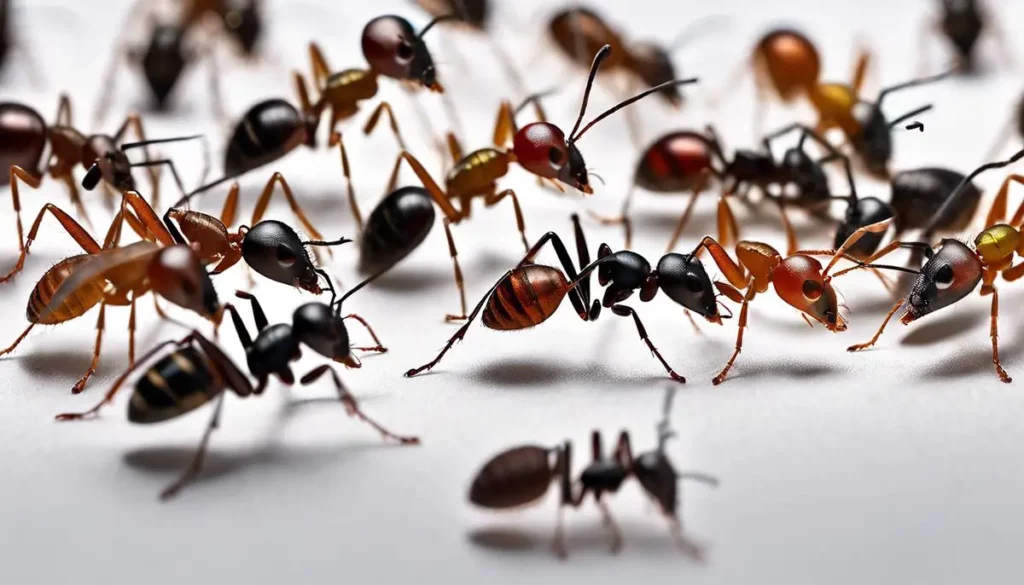
Ant Control Methods
Moving forward on our extraordinary ant-centered journey, let’s delve into the realm of effective ant control methods.
As serious hobbyists of ant-study or myrmecology, it’s our shared responsibility to manage these critters in a way that’s both effective and respectful of the intricate ecological roles they play.
So, where do we start?
Our first line of defense comes in the form of prevention. Ant-proofing your home includes maintaining cleanliness in food areas, sealing any conceivable entry points such as window frames or cracks, and keeping outdoor plants trimmed and extended beyond the house’s boundary. Remember, these pests are seeking food – deny them that, and they’ll likely pack up their tiny ant bags and move on!
Next is baiting, a strategy that extends beyond simple bug sprays. Ant bait includes a slow-working insecticide combined with an enticing food source. Foraging workers carry these poisoned treats back to the colony, infecting and eventually wiping out the entire community – including our prime target, the queen. Baits come in granular, gel, and station forms, each with its intricacies and applications. Granular baits are good for lawns or outdoor areas, while gel and station baits are well-suited for cracks, crevices, and indoor placements.
However, while baits can be little powerhouses of ant destruction, they’re not universal solutions. Different ants have different dietary preferences – some favor sugary foods, others proteins or fats. Variety is the spice of ant life, so employing a combination of baits can address a wider ant spectrum.
If you feel a situation has escalated beyond your control, professional help is your next option. Pest control professionals can provide targeted treatments that acknowledge both the diversity and behavior patterns of the offending species. These experts can also offer advice and measures for preventing future infestations.
Sometimes, particularly with invasive ant species, chemical treatments can be necessary. These can range from dust, granules, sprays, or more serious methods like fumigation or heat treatments for larger infestations. Whenever chemicals are used in ant control, it’s essential to handle them responsibly to limit the ecological impact and potential health risks to humans and pets.
For all our ant-enthusiasts, consider biological control methods, which can be an efficient way of managing ant populations if properly utilized. This involves exploiting natural enemies of ants, such as certain types of insects, birds, or other ant species. Be aware, though, that introducing new species into an ecosystem can have unintended consequences. Always consult with an expert before going down this route.
Remember, patience is key in the world of ant control. It can take time for ants to locate baits and share them with their colonies, and it may take weeks to see a significant reduction in their numbers. But with careful observation, strategic planning, and a willingness to learn, we’ll become ant controlling virtuosos yet. Happy ant-hunting!

Examining the biology of ants and recognizing their species are the initial steps to successfully counteracting an ant infestation. These methods are not only useful for removing the current nuisance but also for avoiding future ones.
Regarding ant control, there are several alternatives available that can cater to various situations, from natural deterrents for minor issues to professional extermination for complex cases. However, whatever method one chooses to utilize, it is paramount to fully understand how to apply it and the safety precautions necessary.
Employing these strategies will lead to an efficient solution, significantly reducing or completely eliminating the discomfort caused by ants while preserving the safety of your home environment.
